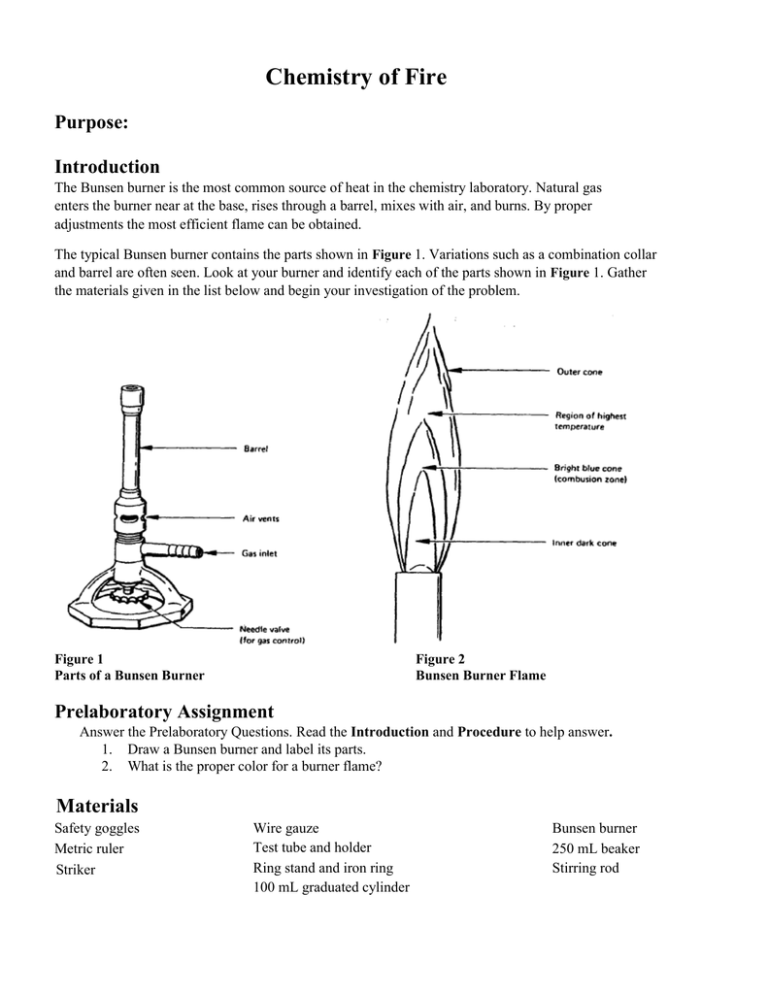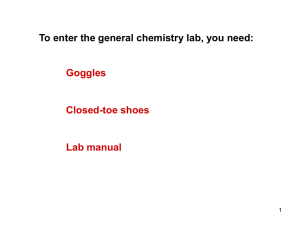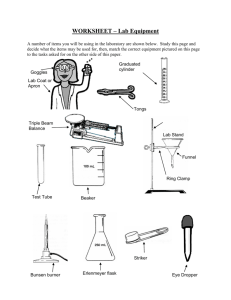Bunsen burner lab
advertisement

Chemistry of Fire Purpose: Introduction The Bunsen burner is the most common source of heat in the chemistry laboratory. Natural gas enters the burner near at the base, rises through a barrel, mixes with air, and burns. By proper adjustments the most efficient flame can be obtained. The typical Bunsen burner contains the parts shown in Figure 1. Variations such as a combination collar and barrel are often seen. Look at your burner and identify each of the parts shown in Figure 1. Gather the materials given in the list below and begin your investigation of the problem. Figure 1 Parts of a Bunsen Burner Figure 2 Bunsen Burner Flame Prelaboratory Assignment Answer the Prelaboratory Questions. Read the Introduction and Procedure to help answer. 1. Draw a Bunsen burner and label its parts. 2. What is the proper color for a burner flame? Materials Safety goggles Metric ruler Striker Wire gauze Test tube and holder Ring stand and iron ring 100 mL graduated cylinder Bunsen burner 250 mL beaker Stirring rod Safety 1.Wear safety goggles and lab apron whenever working in the laboratory. 2. When using a Bunsen burner: Confine long hair and loose clothing Never leave a burner unattended Do not reach over the burner Make sure no flammables are near the burner 3. When heating test tubes: Do not point the open end toward any person Do not heat the bottom of the test tube Procedure Part 1 Use of the Burner Setting the flame 1. Be sure the hose is securely fastened to both the burner and the gas outlet. 2. Turn on the gas to the maximum open position(L shape) and light the burner with the striker. 3. The flame height can be adjusted by turning the needle valve. 4. The flame color can be adjusted by turning the barrel (or opening the air vents). a. If the flame is a yellow color, it is not getting enough air. Use the barrel and air ports to adjust it until it is completely blue and shows an inner cone as illustrated in Figure 2. Too much air will cause the flame to be noisy and possibly blow out. b. If the flame is blue without the inner cone, adjust the barrel or air ports until an inner cone is visible. Heating a test tube 5. Half fill a test tube with tap water. Apply heat to the side of the test tube as shown in Figure 3. Notice that the top of the test tube is at an angle and pointed away from all people in the area. Figure 3 Heating a liquid in a test tube 6 If heat is applied directly to the test tube, the contents will shoot out of the tube or "bump". A slow smooth movement of the tube in and out of the flame should be used to heat the contents evenly. Once the water is boiling, remove the test tube from the flame, discard the water into the sink and set the tube and holder aside to cool. Heating a larger volume of liquid 1. To heat larger amounts of water use the set-up shown in the figure below. Assemble this apparatus now (without the beaker) for use in the next part of your investigation. Place the bottom of the wire gauze about 15.0 cm above the top of the Bunsen burner. 2. Using then pour it the graduated cylinder measure out 90mL of water and into the beaker. 4. Stirring rod 250-ml beaker Iron ring / Wire gauze Bunsen burner 3. Using a thermometer measure the temperature of the water in the beaker. Once the temperature reaches 75° C turn off the gas and let beaker cool, while you answer the questions below with your lab group. Cleaning Up 1. Any broken glass should be carefully placed in a labeled container for broken glass. 2. Carefully clean your glassware and return all of your equipment to its proper location. The burner, ring, ring stand and wire gauze may be hot. Check back at the end of class to see if they can be put away. 3. Wash your hands before leaving the laboratory. ' Conclusions questions: 1. Describe the flame when there is NOT enough oxygen present(valve closed)? 2. What are the advantages of using a blue flame instead of a yellow one for heating objects in the laboratory? Where is the hottest part of the blue flame? 3. 4. When heating a substance over a Bunsen burner where should the object be placed for most efficient heating? Why?







